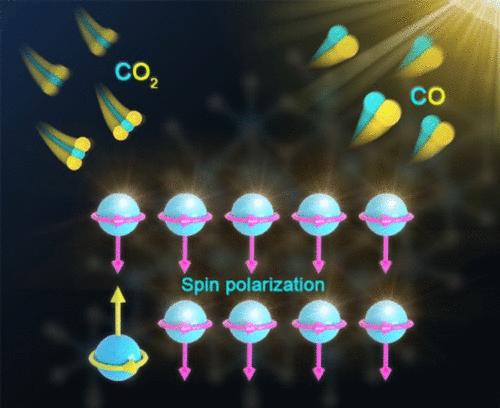通过自旋极化操纵优化光催化二氧化碳还原反应动力学和热力学
IF 11.3
1区 化学
Q1 CHEMISTRY, PHYSICAL
引用次数: 0
摘要
电子的固有特性 "自旋 "对化学反应,尤其是催化反应的反应速率和途径有重大影响。值得注意的是,电子自旋极化(SP)的影响已被证实会对光催化过程产生重大影响,但其确切机制仍不清楚。在本研究中,我们通过策略性地调节 Co3-xO4 中的钴空位(VCo),实现了对材料自旋极化程度的可控操纵,磁性圆二色性(MCD)、正电子湮灭光谱、X 射线吸收精细结构(XAFS)和密度泛函理论(DFT)计算均证实了这一点。载流子动力学研究表明,材料固有的 SP 和外部磁场增强的 SP 能显著提高电荷载流子的迁移率,同时减弱光诱导载流子的重组。值得注意的是,SP 在二氧化碳还原过程中具有热力学优势,有利于反应物的吸附,同时降低了决定速率步骤所需的自由能。值得注意的是,通过操纵 Co3-xO4 中的 SP 并施加外部磁场,二氧化碳的生产率达到了 0.354 μmol h-1(5 毫克催化剂),选择性为 100%。这项研究揭示了 SP 对光催化反应的影响机制,为二氧化碳还原光催化剂的设计提供了启示。本文章由计算机程序翻译,如有差异,请以英文原文为准。

Optimizing Reaction Kinetics and Thermodynamics for Photocatalytic CO2 Reduction through Spin Polarization Manipulation
The intrinsic properties of electrons, “spin”, significantly influence chemical reactions, particularly in catalysis, in terms of reaction rates and pathways. Notably, the effect of electron spin polarization (SP) has been demonstrated to significantly impact photocatalytic processes, yet the exact mechanism remains unclear. In this study, we achieved a controlled manipulation of the material’s SP degree by strategically modulating the Co vacancies (VCo) within Co3–xO4 as corroborated by magnetic circular dichroism (MCD), positron annihilation spectroscopy, X-ray absorption fine structure (XAFS), and density functional theory (DFT) calculations. Carrier kinetic investigation reveals that the inherent SP of the material and external magnetic field augmented SP significantly enhances charge carrier mobility while attenuating the recombination of photoinduced carriers. Significantly, SP confers a thermodynamic benefit in CO2 reduction, favoring reactant adsorption and concurrently diminishing the free energy requisite for the rate-determining step. Remarkably, a CO production rate of 0.354 μmol h–1 (5 mg of catalyst) with 100% selectivity is achieved through manipulation of SP within Co3–xO4 and applying an external magnetic field. This work reveals the mechanisms of SP effects on photocatalytic reactions, offering insights into the design of CO2 reduction photocatalysts.
求助全文
通过发布文献求助,成功后即可免费获取论文全文。
去求助
来源期刊

ACS Catalysis
CHEMISTRY, PHYSICAL-
CiteScore
20.80
自引率
6.20%
发文量
1253
审稿时长
1.5 months
期刊介绍:
ACS Catalysis is an esteemed journal that publishes original research in the fields of heterogeneous catalysis, molecular catalysis, and biocatalysis. It offers broad coverage across diverse areas such as life sciences, organometallics and synthesis, photochemistry and electrochemistry, drug discovery and synthesis, materials science, environmental protection, polymer discovery and synthesis, and energy and fuels.
The scope of the journal is to showcase innovative work in various aspects of catalysis. This includes new reactions and novel synthetic approaches utilizing known catalysts, the discovery or modification of new catalysts, elucidation of catalytic mechanisms through cutting-edge investigations, practical enhancements of existing processes, as well as conceptual advances in the field. Contributions to ACS Catalysis can encompass both experimental and theoretical research focused on catalytic molecules, macromolecules, and materials that exhibit catalytic turnover.
 求助内容:
求助内容: 应助结果提醒方式:
应助结果提醒方式:


